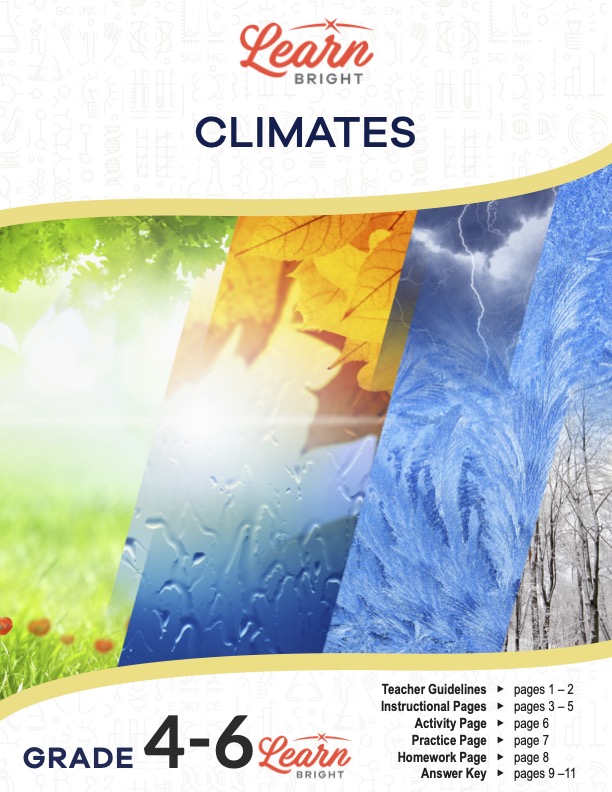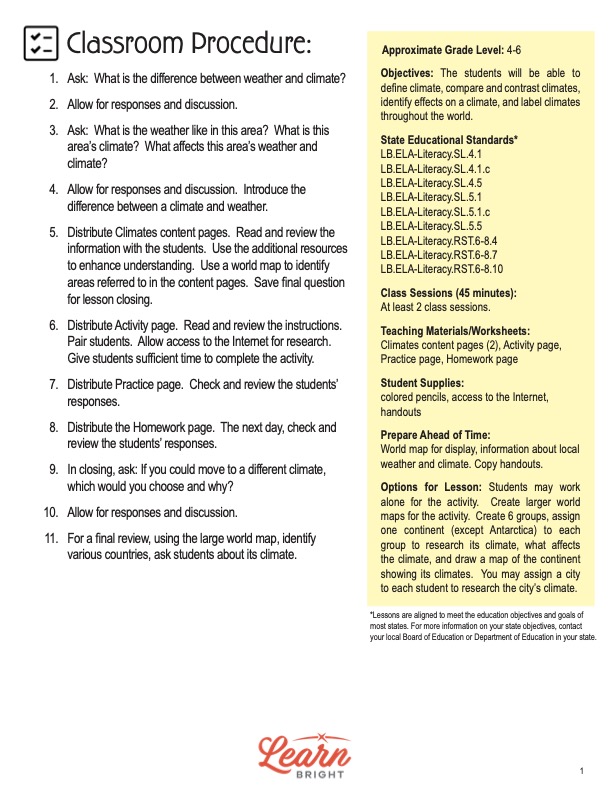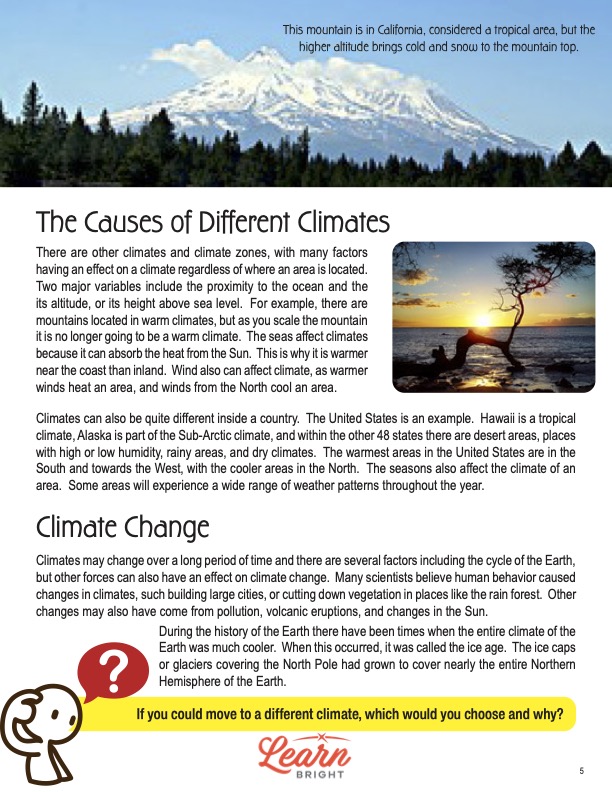Description
What our Climates lesson plan includes
Lesson Objectives and Overview: Climates teaches students how to define an area’s normal weather over a long period of time. Students will learn some traits of specific climate types and be able to explain how certain things can affect them. They will compare and contrast different types and be able to accurately label areas of the world that have these weather patterns. This lesson is for students in 4th grade, 5th grade, and 6th grade.
Classroom Procedure
Every lesson plan provides you with a classroom procedure page that outlines a step-by-step guide to follow. You do not have to follow the guide exactly. The guide helps you organize the lesson and details when to hand out worksheets. It also lists information in the yellow box that you might find useful. You will find the lesson objectives, state standards, and number of class sessions the lesson should take to complete in this area. In addition, it describes the supplies you will need as well as what and how you need to prepare beforehand. In addition to the handouts, the only other supplies you will need are colored pencils. You will also need to ensure students have Internet access.
Options for Lesson
In the “Options for Lesson” section, you will find a number of ideas for additional activities or alternate ways to go about certain parts of the lesson. One idea is to create larger world maps for the activity rather than having students complete the smaller map on the worksheet itself. Another option is to divide students into six groups and assign each group a continent (omitting Antarctica) to research. Each group will gather information about the continent’s climates and their effects on the different areas. They can draw a map of the continent and, similar to the activity, color in the areas with different climates using different colors. One more idea is to assign a specific city to each student to research and present to the class.
Teacher Notes
The teacher notes pages provides one more paragraph of information or guidance for the lesson. It suggests you use videos that show examples of various climates in other parts of the United States or the world overall. You can use the blank lines on this page to write down any last minute thoughts or ideas you have before presenting the lesson to your class.
CLIMATES LESSON PLAN CONTENT PAGES
What Is a Climate?
The Climates lesson plan contains three pages of content. The first page shows three pictures of areas with different climates to help students easily recognize the differences between climates. It then explains the difference between an area’s climate and its weather. Weather can change from day to day, and usually according to the season. However, an area’s climate involves the normal weather of the area over a long period of time. The two terms do not mean the same thing. Weather changes from day to day, and sometimes from hour to hour. Climates do not change very much. If they do, it takes a very long time for the change to actually take place — sometimes thousands of years!
Students will explore the three main groups of world climates: arctic, tropical, and temperate. They will learn that the location of a country, such as one close to the ocean versus one that is landlocked, and a country’s elevation affect its climate. The three groups further split into other climate divisions.
Arctic, Tropical, and Temperate
The arctic category splits into polar and sub-arctic climates. A polar climate does not support life. It is the climate of both the Arctic and the Antarctic. In the Antarctic, the temperature never rises above freezing! In the Arctic, however, there is a short period of time in which temperatures go above freezing, causing some ice to melt.
Greenland, Labrador, Alaska, Northern Canada, and the far north area of Scandinavia and Siberia boast the sub-arctic climate. During wintertime in these areas, temperatures fall below zero, and rivers and lakes freeze over. However, the summer months allow lakes and rivers to thaw, and the plants on the tundra can support some animal wildlife.
The tropical climates divide further into equatorial, tropical, and desert (arid). In equatorial areas, which are places along the equator, there is heavy rainfall year round and temperatures are always high. Tropical areas are further north or south of the equator. Temperatures are still high, but heavy rains only occur during summertime. Desert areas in this region of the world are extremely dry and hot and receive very little to no rain throughout the year.
Finally, temperate climates are split between warm and cool. In warm areas, the winters are usually mild and wet, and summers are hot and dry. This also includes the Mediterranean climate. In cool areas, winters are cold and summers are warm. During the winter, there is snow and freezing temperatures for short periods of time. Rain falls throughout the year, but less so in the summer than in the winter months.
Causes and Climate Change
The final page explains what causes areas to have certain climates. Many factors can affect an area’s climate regardless of where it is. Students will discover two major variables: proximity to the ocean and a place’s altitude (height above sea level). For instance, there are mountains in warm climates, but the higher a person climbs, the cooler it gets. The seas affect climates because they absorb heat from the sun. Therefore, coastal areas are generally warmer than inland areas. Wind can affect climate as well. Warmer winds heat an area up while cooler winds lower the temperature.
A single country can experience multiple climates. The United States, for example, is fairly large. Hawaii is a tropical climate. Alaska is a sub-arctic climate. The other 48 states include desert areas, dry areas, and rainy areas. The warmest parts of the country are in the South and toward the West. The coolest areas are in the North.
Climates can change over a long period of time, and several variables affect such changes, such as the cycle of the earth. However, other forces can affect climate change. Many scientists believe human behavior has caused changes in climates, such as building large cities or cutting down vegetation in rainforests. Pollution, volcanic eruptions, and changes in the sun might also play a role. Millions of years ago, the earth was much cooler. The ice caps or glaciers covering the North Pole nearly covered the entire northern hemisphere of the earth. Historians call this time the Ice Ages.
Key Terms
Here is a list of the vocabulary words students will learn in this lesson plan:
- Climate: a country’s normal weather over a long period of time
- Weather: the temperature and conditions of an area specific to each day
CLIMATES LESSON PLAN WORKSHEETS
The Climates lesson plan includes three worksheets: an activity worksheet, a practice worksheet, and a homework assignment. Each of these handouts will help students better grasp the material they learned during the lesson. You can follow the guide on the classroom procedure page to know when to hand out each worksheets to the students.
WORLD ATLAS ACTIVITY WORKSHEET
For the activity, students will research the climate zones found throughout the world. They will create a legend at the bottom of the worksheet to keep track. Using different colors for each zone, they will color the map according to the weather patterns of the regions. Students can work alone, in pairs, or in small groups depending on what you prefer.
MATCHING PRACTICE WORKSHEET
The practice worksheet requires students to read through 25 descriptions. Using the terms in the word bank, students must match the statements to the climates they represent. There are only seven options in the word bank, so students will use each three or four times.
CLIMATES HOMEWORK ASSIGNMENT
There are two sections for the homework. The first section lists 15 questions. Students must answer each question using what they’ve learned throughout the lesson. The second part requires students to read seven statements and figure out which climate type they refer to.
Worksheet Answer Keys
The final pages of this lesson plan are answer keys for the worksheets. The answer keys for the practice worksheet and the homework assignment are simple and provide the correct answers in red. Students’ responses should not differ from those of the answer keys. For the activity worksheet, students’ maps may look a little different from the one on the answer key. However, the areas representing the different climates should be fairly close to the way the answer key represents these zones. If you choose to administer the lesson pages to your students via PDF, you will need to save a new file that omits these pages. Otherwise, you can simply print out the applicable pages and keep these as reference for yourself when grading assignments.










